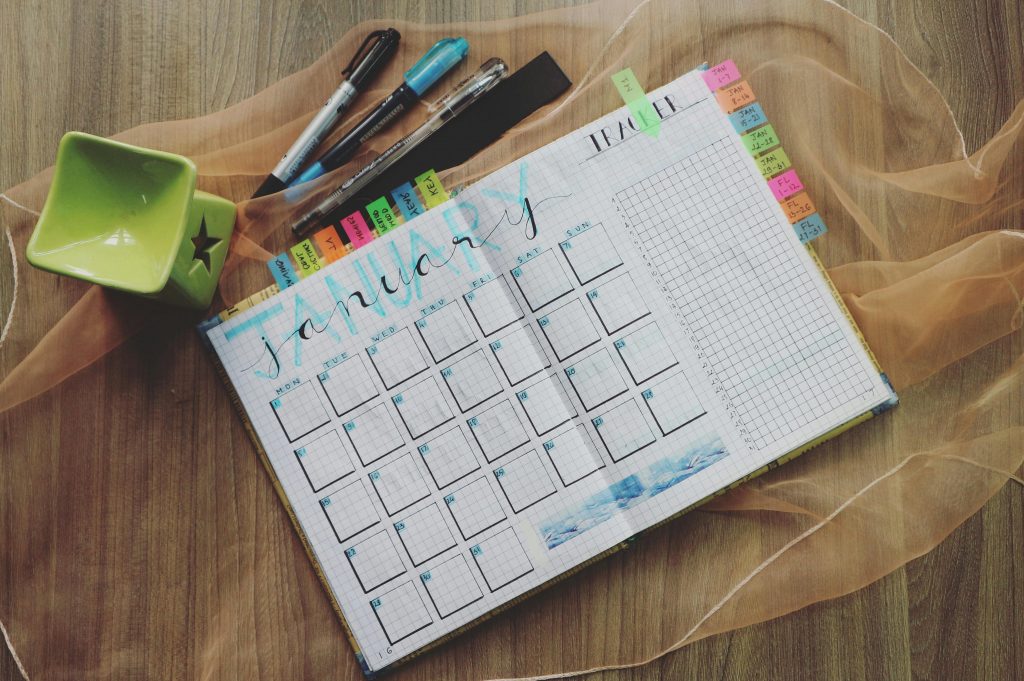
In 2020, when the world was shut down, everyone tried to pick up a new hobby. Whether it was learning to bake the perfect sourdough bread, perfecting a TikTok dance, learning an instrument, or painting, there was something for everyone. In an attempt to feel some sense of control over my days and build a healthy routine, I picked up bullet journalling.
Bullet journaling is when someone expresses themselves in a diary or a notebook. The process of creating a bullet journal is typically done by hand, with either more or fewer words since some use their bullet journal for writing entries to get their thoughts out before drawing or decorating the page. It can also be used for tracking one’s life aspects (i.e. daily moods, books read, daily water intake), organizing one’s calendar, and/or as a planner. There is no one right way to create or structure a bullet journal because it is highly individualized and meant to be a fun, creative outlet while having some practical uses (Tholander & Normark, 2020).
With the state of the world back in 2020 and the constant worry of the future, I was struggling to maintain normalcy. Every day was tough because who knew what would happen next, and then there was the dread that each day was a repeat of the last day, week, and month. Personally, productivity was down the drain and procrastination was at an all-time high as it was for others, but a bullet journal calendar broke my cycle of dread because I knew what to look forward to. There wasn’t any instantaneous impact though, but that doesn’t negate the long-term benefits for me since I started taking things one month at a time.
At first, I used my old high school notebook for a monthly calendar spread with each month having a designated theme and colours. For instance, I often associated April with blue and grey hues, raindrops and rainclouds, whereas May would also have bright colours and springtime themes such as flowers or picnics. Sometimes, if there was a big festival or holiday to look forward to, it would control the themes for the month like Christmas for the month of December and Valentine’s Day for the month of February. Your bullet journal is what you make of it!
Bullet journalling is also an excuse to shop for cute stationary no matter if it’s to keep track of special dates or simply plan your month. For some, drawing, and painting is a way to practice self-care, and for others, it’s a way to learn to be creatively expressive. It is very beginner-friendly and doesn’t have to be an expensive hobby necessarily since Crayola markers or pencil crayons work just fine. Digital bullet journalling is an option too, but I prefer the physical version of making one.
What started as a way to worry about one day/week/month at a time and be creative evolved into something to keep track of short-term goals and achieve long-term goals. After laying down important dates and appointments in the calendar, every night I would make a mini list of things to accomplish for the next day to maintain productivity and reduce procrastination. Not only did it break down long-term goals into smaller steps, but it also helped to know what to expect the next day when the future was uncertain during the pandemic. Nowadays, my bullet journal calendar allows me to stay atop my school deadlines and commitments so I can manage my time appropriately. Starter tip: only on the 25th to 27th of every month would I start the calendar for the next month because it allowed me to worry about things in the near future and leave things out of my control as a worry for another month.
Overall, there are many benefits to bullet journalling. Because there isn’t a wrong way to do it, and it allows for the usage of cute materials, it is a hobby anyone can try and incorporate into everyday life. Although I found it beneficial for managing my time, achieving my goals, and gaining a sense of control over my life, Tholander and Normack (2020) found it beneficial for showcasing personal growth, maintaining growth, and reflecting on the past. Whether a person uses a bullet journal to plan their month, write out their thoughts before decorating the page, or track their daily habits such as water intake, movies watched and hours slept, experimenting is part of the process.
Reference
Tholander, J., & Normark, M. (2020, April). Crafting personal information-resistance, imperfection, and self-creation in bullet journaling. Proceedings of The 2020 Chi Conference on Human Factors in Computing Systems (pp. 1-13).
Note: The Free Your Mind Mental Health Society is an independent youth-led organization. The contents of this blog are not intended to be a substitute for professional medical advice, diagnosis, or treatment. Always seek the advice of your physician or another qualified health provider with any questions you may have regarding a medical condition. In the event of a medical emergency, please call your doctor or 911 or other local emergency numbers immediately.

